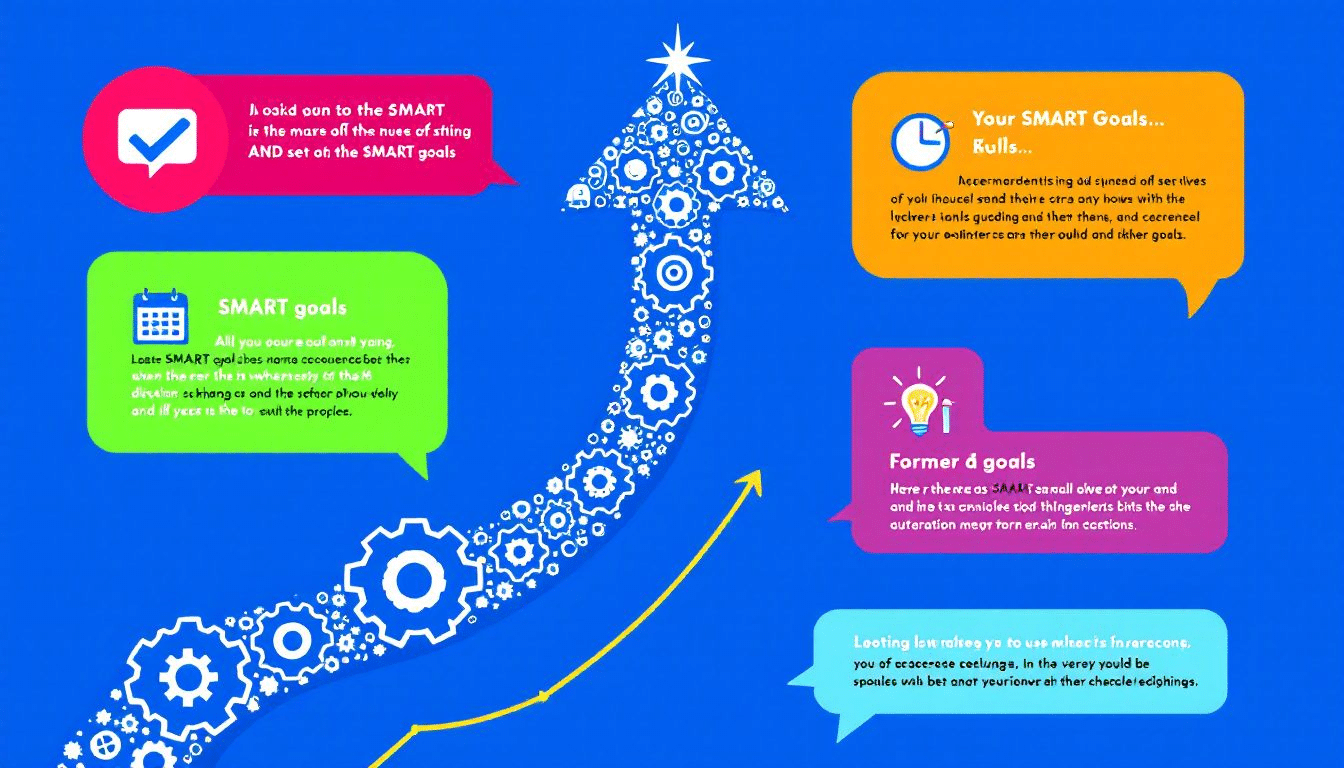SMART goals provide a clear framework that helps individuals and organizations set and achieve objectives effectively. Unlike vague goals, SMART goals are specific, measurable, achievable, relevant, and time-bound. This approach enhances clarity, increases motivation, and improves performance. This article will explore the key advantages of SMART goals and how they can transform your goal-setting process.
Key Takeaways
-
SMART goals provide a clear, structured approach that enhances clarity and focus in achieving objectives.
-
Incorporating SMART goals increases motivation, commitment, and the likelihood of success by breaking down larger goals into manageable steps.
-
Efficient resource allocation and better time management facilitated by SMART goals lead to greater productivity and enhanced performance.
Mastering Success: The Top Advantages of SMART Goals

The SMART goal method is a structured approach designed to formulate and manage goals effectively and efficiently. The primary purpose of the SMART framework is to set clear, achievable goals that align with broader aims and are easy to measure. SMART goals enhance the likelihood of success by eliminating ambiguity and providing clear targets, which helps gauge progress along the way.
What makes SMART goals particularly effective is their specificity. Rather than vague aspirations, SMART goals are specific, measurable, achievable, realistic, and time-bound. This clear structure ensures that objectives are understandable and attainable, providing a roadmap that reduces the chances of failure caused by vague objectives. Whether you’re an individual aiming for career advancement or an organization striving for business success, SMART goals offer a reliable framework for achieving targeted results.
Moreover, the SMART methodology transforms long-term goals into a structured path with clear benchmarks. This approach not only improves overall goal achievement but also brings clarity into project management, enhancing performance and productivity. SMART goals enhance focus, motivation, and commitment for individuals and teams, ultimately increasing the likelihood of success.
Introduction
Setting goals is essential for guiding actions and achieving desired outcomes. However, not all goals are created equal. The SMART goals method stands out as a strategy for setting meaningful goals that define and achieve objectives. Adhering to the five smart criteria of specific, measurable goals, achievable, relevant, and time-bound, SMART goals offer a clear sense of direction and purpose.
SMART goals are widely utilized across various fields such as management, marketing, education, and psychology. This widespread adoption underscores their effectiveness in providing motivation and commitment, helping individuals track progress and measure success using smart criteria through smart goal setting with a smart goals template.
As we dive deeper into the advantages of SMART goals, you’ll discover how they can transform your goal-setting process and lead you to success.
Enhanced Clarity and Focus
One of the most significant advantages of SMART goals is the enhanced clarity and focus they provide. The SMART framework is designed to set clear and achievable goals, eliminating ambiguity and providing specific targets for success. This clear path ensures that objectives are understandable and attainable, reducing the likelihood of failure caused by vague goals.
Setting SMART goals allows individuals and teams to narrow their focus and align their efforts with broader aims. This structured approach transforms long-term aspirations into a series of manageable steps, each with its benchmarks and milestones, creating a smart acronym for success. The result is a clear roadmap that guides actions and decisions, enhancing overall goal achievement.
Increased Motivation and Commitment

SMART goals also play a crucial role in increasing motivation and commitment. Celebrating achieved milestones reinforces a sense of accomplishment, boosting motivation and encouraging continued effort. Rewarding yourself for reaching these milestones can further enhance your commitment to the goal-setting process.
Breaking down larger goals into smaller, achievable steps helps maintain focus and commitment. This approach not only makes ambitious goals more manageable but also improves productivity and self-esteem as progress is tracked and celebrated.
Clear and achievable goals help individuals stay motivated and committed, even when circumstances change.
Better Time Management

Time management is another area where SMART goals excel. Time-based objectives create a sense of urgency, improving focus and ensuring that relevant tasks are completed promptly. Defining specific timeframes for goals helps individuals maintain their energy and attention on the most important tasks.
Regularly tracking progress using relevant metrics ensures that SMART goals remain on track and aligned with overall objectives. This continuous monitoring helps identify any deviations from the plan and allows for timely adjustments, ensuring that goals are achieved within the set time limits.
Ultimately, SMART goals facilitate better time management, leading to greater productivity and success.
Efficient Resource Allocation
SMART goals are instrumental in efficient resource allocation. Clarifying necessary steps to reach specific objectives, SMART goals enable more effective resource allocation for individuals and organizations. This structured approach prevents resource wastage and ensures that human, financial, and material resources are utilized in areas of greatest need.
Defining SMART objectives allows project managers to strategically distribute resources, enhancing overall productivity and success. Whether it’s organizing available resources or leveraging other resources, the SMART framework provides a clear plan for achieving goals while optimizing resource use.
This efficient allocation of resources is key to both individual skill improvement and organizational success.
Improved Performance Management
SMART goals significantly improve performance management by providing a structured framework for measuring success. Aligning goals with key values and broader organizational objectives, SMART goals establish relevant benchmarks for performance reviews. This alignment fosters personal growth and contributes to the overall success of the company.
Regular progress reviews and feedback are vital for keeping employees motivated and on track with their SMART goals. These reviews provide trackable metrics to evaluate project success and offer clarity in goal-setting and project management.
Incorporating SMART objectives into management systems enhances cohesion and alignment in objectives, ultimately improving employee satisfaction and performance.
Higher Likelihood of Success

The likelihood of success is significantly higher when using SMART goals. Setting achievable and realistic goals fosters confidence and a strong sense of direction for individuals and teams. The SMART approach minimizes the risk of failure by avoiding vague and unrealistic goals, ensuring that resources and time are committed effectively.
Achievable goals contribute to motivation and commitment, making success more likely. Conducting evaluations of SMART goals can reveal successes and areas needing improvement, providing valuable insights for future goal-setting.
This continuous cycle of setting, evaluating, and adjusting goals ensures that individuals and organizations stay on track towards their objectives.
Personal and Professional Growth
SMART objectives are crucial for personal and professional growth. SMART goals help individuals identify their strengths and weaknesses, providing a clear path for development. Each component of the SMART framework, such as being specific and measurable, plays a vital role in effective professional development.
Mentorship and support systems are also key to utilizing SMART goals effectively. For instance, Mary used SMART objectives to guide her professional development, which propelled her career and positively impacted her team and organization. A mentor provided insights into leadership and helped refine Mary’s objectives, showcasing the role of mentorship in achieving SMART goals.
Moreover, aligning personal goals with organizational objectives is a significant advantage of using SMART goals. Encouraging collaborative learning and sharing resources within a team fosters a supportive environment that enhances personal and professional growth. However, it’s important to balance the emphasis on SMART objectives with personal satisfaction and well-being.
Balanced Goal Setting
Balanced goal setting is essential for sustainable success. Flexibility in goal setting allows individuals to pivot and adapt their strategies in response to changing circumstances. This adaptability helps in coping with uncertainties and enhances overall well-being.
Clear time-bound objectives help manage stress and prevent burnout by setting realistic deadlines. However, constant focus on time-bound criteria can induce significant pressure and potentially decrease morale.
Setting broader objectives with key milestones allows for adjustments as needed, promoting resilience and a flexible approach to achieving goals.
Practical Examples of SMART Goals

To illustrate the effectiveness of SMART goals, let’s look at some practical smart goal example across various fields. In IT, a SMART goal might focus on improving website load times by 20% over three months through server resource optimization and code refinement. For research and development, a SMART goal could be to develop and launch two new product prototypes in Q4, with feedback from at least 100 potential customers.
In training and employee development, a SMART goal may involve launching a new training module each quarter, aiming for a satisfaction rating of 90% or higher from participants. Administrative tasks can benefit from SMART goals such as cutting paperwork processing time by 25% over the next six months by implementing a digital documentation system. These examples highlight how SMART goals can significantly improve personal and professional development outcomes.
Operations can also benefit from SMART goals, such as reducing product defect rates from 4% to 2% in six months through enhanced quality control processes. In sales and marketing, a SMART goal might be to increase the client base by 10% in the next quarter, monitored through new signed contracts.
These practical examples demonstrate the versatility and effectiveness of SMART goals in achieving measurable outcomes across various domains.
Best Practices for Implementing SMART Goals
Implementing SMART goals effectively requires aligning individual goals with broader organizational objectives. Involving employees in goal-setting enhances their sense of ownership and engagement, which improves productivity. Managers play a crucial role in assisting employees to align their personal goals with company priorities, fostering a cohesive and motivated workforce.
Using a SMART goal worksheet can help in creating well-planned actions for SMART goals. It’s also important to set diverse types of goals to optimize the overall performance review process.
Avoiding common mistakes in creating SMART or SMARTER goals is essential for their successful implementation.
Regular Review and Adjustment
Regular reviews and adjustments to SMART goals are essential for maintaining their relevance and effectiveness. Evaluating results against expectations allows for necessary adjustments based on performance insights. If goals become irrelevant or too easy/hard, adjustments should be made to ensure they remain challenging yet achievable.
Documenting learnings from the goal-setting process improves future goal formulation and helps identify effective strategies for achieving objectives. This cycle of reviewing and adjusting goals should be repeated regularly for ongoing relevance and effectiveness.
Continuous evaluation and adaptation ensure that SMART goals stay aligned with changing circumstances and remain a driving force for success.
Integration with Organizational Strategy
Aligning SMART goals with the broader organizational strategy fosters cohesion and enhances the likelihood of achieving long-term objectives. By integrating SMART goals with organizational strategies, individuals and teams ensure that their objectives contribute to the overall mission and vision of the organization.
A systematic and methodical approach that aligns with the long-term strategic vision is essential when integrating SMART objectives. This alignment not only ensures that individual efforts are in sync with organizational goals but also enhances the overall effectiveness and efficiency of the goal-setting process.
Utilizing Support Systems
Mentorship and support systems play a crucial role in achieving SMART objectives by providing guidance and resources. Support systems like accountability partners or mentors can enhance commitment and provide encouragement in achieving SMART goals.
Support systems assist in overcoming challenges associated with achieving SMART goals by offering valuable resources and guidance. Collecting stakeholder feedback helps validate assumptions and identify areas for improvement, ensuring that SMART goals are well-supported and effectively pursued.
Summary
In summary, SMART goals offer a structured and effective approach to goal setting that enhances clarity, motivation, and resource allocation. By aligning goals with broader organizational objectives and regularly reviewing and adjusting them, individuals and teams can achieve greater success. The use of support systems and mentorship further strengthens the commitment and effectiveness of SMART goals.
As you embark on your goal-setting journey, remember that SMART goals are not just about setting objectives but about creating a clear path to success. Embrace the SMART framework, stay flexible, and continuously evaluate your progress. With SMART goals, you can turn your aspirations into achievements and reach new heights in both your personal and professional life.
FAQ
What are SMART goals?
SMART goals empower you to set clear, actionable objectives that are specific, measurable, achievable, relevant, and time-bound. By using this framework, you can stay focused and motivated to achieve your aspirations!
How do SMART goals enhance motivation and commitment?
SMART goals significantly enhance motivation and commitment by breaking down larger objectives into manageable steps, allowing you to celebrate milestones along the way. This structured approach keeps you focused and energized on your journey to success!
Why is regular review and adjustment important for SMART goals?
Regular review and adjustment keep your SMART goals relevant and effective by allowing you to make necessary changes based on your progress. Stay flexible and committed to achieving your goals!
How do SMART goals improve resource allocation?
SMART goals enhance resource allocation by clearly defining objectives, which allows individuals and organizations to focus their resources where they are most needed, minimizing waste. This focused approach maximizes efficiency and effectiveness in achieving your goals!
Can you provide an example of a SMART goal in a professional setting?
A powerful example of a SMART goal is to increase your client base by 10% in the next quarter through new signed contracts. By making this goal specific, measurable, achievable, relevant, and time-bound, you’re setting yourself up for significant success!
